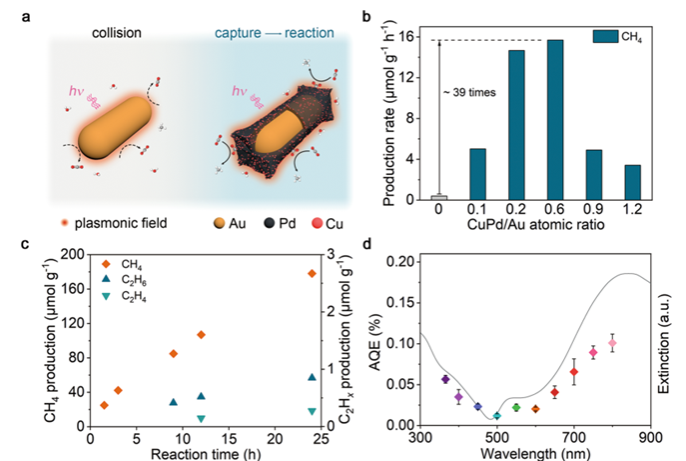To synthesize hydrocarbon via sunlight, CO2, and water is commonly seen in the nature, especially amongst plant kingdom, but remains a challenging and inviting issue in science amidst growing interest in pursuing new and clean energy. Recently, a research team led by Prof. XIONG Jieyu from the University of Science and Technology of China (USTC) reports a broadband plasmon-induced CO2 reduction reaction, which achieves a CH4 production rate of 0.55mmol g-1 h-1 with 100% selectivity to hydrocarbon products. The work is published in Nature Communications.
Artificial photosynthesis seems to usher in a promising energy future bypassing the exhaustion of coal and oil resources. The method has been studied for many years and gets stuck in the low utilization efficiency of low-energy photons, especially near-infrared photons. A mass of semiconductors and metal nanocatalysts have been studied to solve the problem. Among them, plasmonic metal nanoparticles have proved their capacity in absorbing low-energy photons but fail in energy coupling into the reactant molecules.

Plasmon-induced CO2 reduction reaction (Image by Prof.XIONG Jieyu’s team)
Researchers in Prof. XIONG Jieyu’s team focused on solar-to-chemical energy conversion and optimized the system by employing versatile co-catalysts to establish an effective bridge for transferring hot carriers from plasmonic materials into reactant molecules. They found that the localized electric field could lead to the emergence of a new isolated state above the Fermi energy and the differentiation of electron transfer within different molecular orbitals, thus enabling such a unique artificial photosynthesis process. Through their method, they have eventually achieved an extraordinary CH4 production rate of 0.55 mmol g-1 h-1 via a gas-solid biphase system, which successfully hits a record high.
The work breaks the long-standing block and proves the viability of low-energy photon utilization and utilization efficiency improvement of the solar spectrum. Also, it provides a riveting picture of the potential of plasmon-induced catalysis toward achieving broadband artificial photosynthesis and makes artificial photosynthesis move further towards techno-economic applications.
(Written by CHEN Hang, edited by SHU Yukang, USTC News Center)